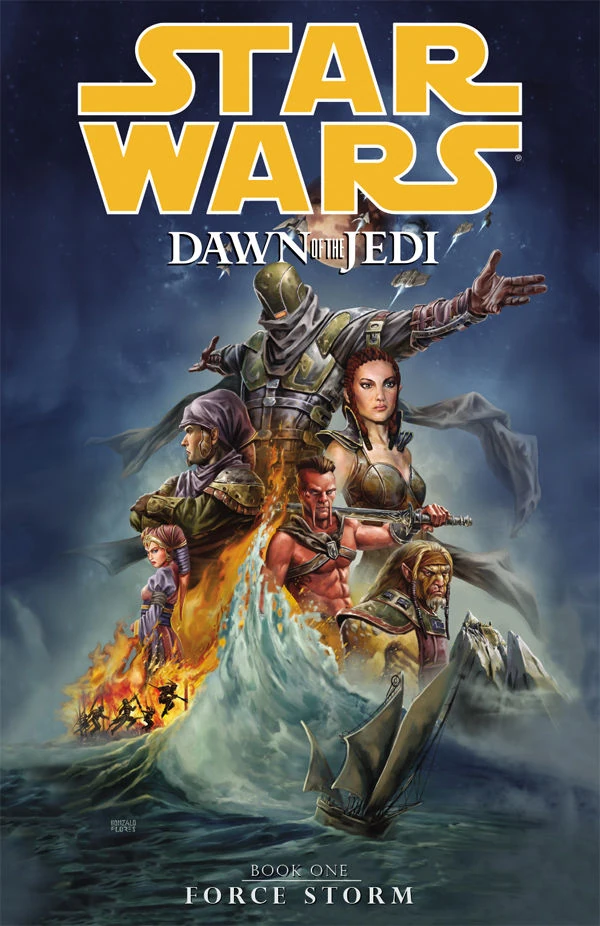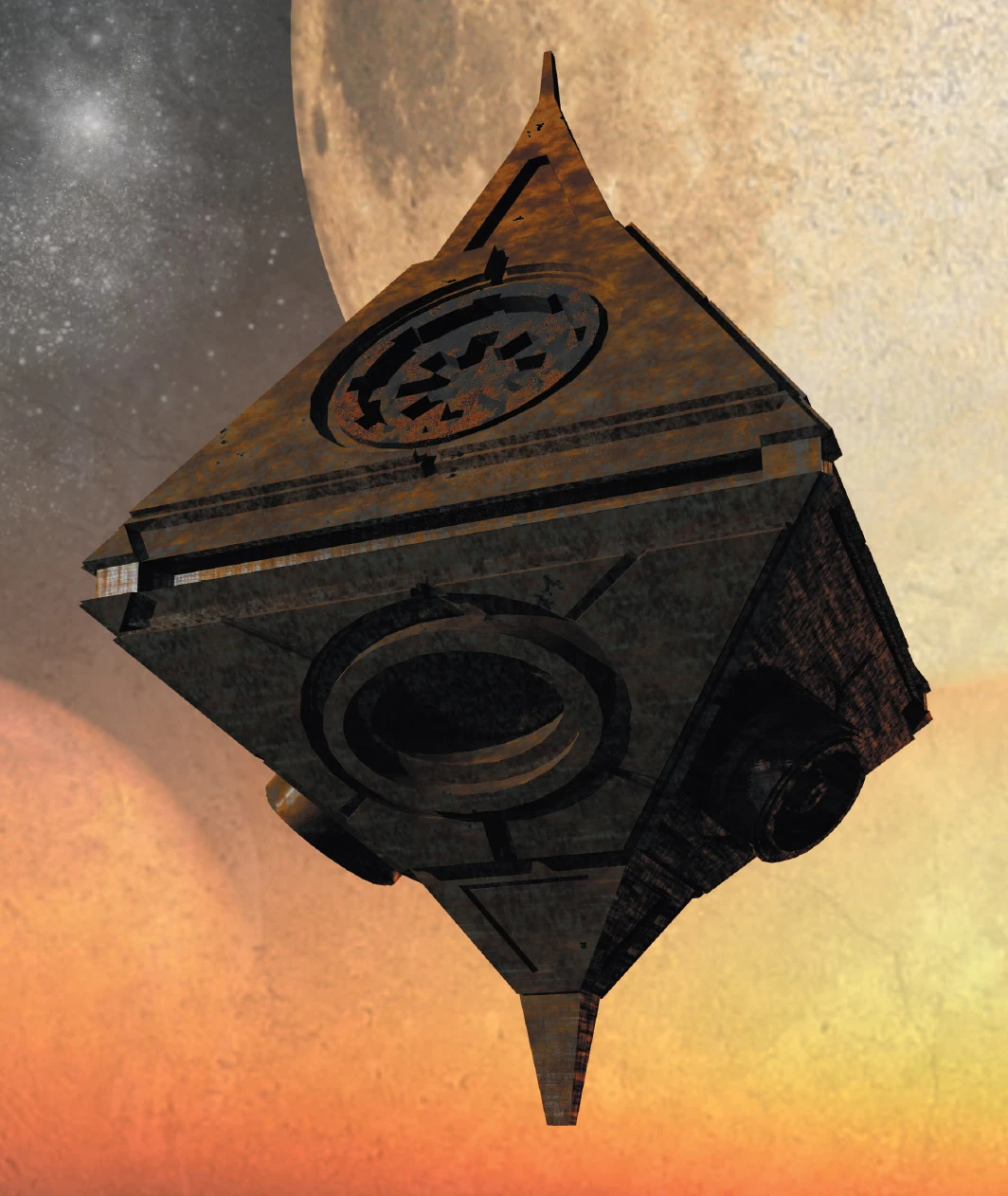As I mentioned in my second post, I'm working on a chronological read-through of Star Wars stories, specifically those from the old expanded universe (so-called "Legends" continuity, which the new movies eschew in favour of their own original stories, a move I wholeheartedly endorse).
I began this read-through well before starting this blog, so I'm going to catch up a bit with what I've already read, beginning with the earliest stories, those labeled "Dawn of the Jedi".
I'll be discussing a total of five titles here:
I began this read-through well before starting this blog, so I'm going to catch up a bit with what I've already read, beginning with the earliest stories, those labeled "Dawn of the Jedi".
 |
| Cover of Dawn of the Jedi Volume 1: Force Storm. Image from Wookieepedia |
- Dawn of the Jedi: Eruption (short story by John Ostrander, 2013)
- Dawn of the Jedi: Into the Void (novel by Tim Lebbon, 2013)
- Dawn of the Jedi 0 (comic handbook, 2012)
- Dawn of the Jedi: Force Storm 1-5 (comic, 2012)
- Dawn of the Jedi: Prisoner of Bogan 1-5 (comic, 2012-2013)
- Dawn of the Jedi: Force War 1-5 (comic, 2013-2014)
The comics were all written by John Ostrander and drawn by Jan Duursema.
I read the paperback of Into the Void, which included the Eruption short story, and all sixteen comics in issue form.
Previous material had alluded to the origin of the Jedi. We knew about the planet Tython, on which the Jedi Order was founded. We knew they used the terms Ashla and Bogan to refer to the light and dark sides of the Force. We knew that this ancient order was destroyed during the Force Wars between light and dark factions, with the light faction prevailing and becoming the modern Jedi Order. But the details were lost to history. Our Jedi characters visit Tython in Star Wars: The Old Republic, but by that time so much is in ruins; so much knowledge is lost.
I read the paperback of Into the Void, which included the Eruption short story, and all sixteen comics in issue form.
 |
| Cover of Dawn of the Jedi: Into the Void. Image from Wookieepedia |
Story:
These stories all take place primarily in the year 25,793 BBY (note that in Star Wars terminology, BBY means before the Battle of Yavin, the epic space battle at the conclusion of Star Wars Episode IV: A New Hope). Some of the background takes place close to 11,000 years earlier, in 36,453 BBY. These stories are extremely far removed from the rest of the Star Wars universe.Previous material had alluded to the origin of the Jedi. We knew about the planet Tython, on which the Jedi Order was founded. We knew they used the terms Ashla and Bogan to refer to the light and dark sides of the Force. We knew that this ancient order was destroyed during the Force Wars between light and dark factions, with the light faction prevailing and becoming the modern Jedi Order. But the details were lost to history. Our Jedi characters visit Tython in Star Wars: The Old Republic, but by that time so much is in ruins; so much knowledge is lost.
The fifteen comic book issues serve as the main Dawn of the Jedi saga. The 0-issue was simply a handbook further describing a complicated world we knew so little about going in. The novel was a fun story set in that world, but with limited connection to the main saga (near the end of Into the Void, the protagonist hears about the events of the first comic arc). The short story served to connect the novel and comic lightly, if only to make clear that these were set alongside each other (Eruption featured the main character from Into the Void and one character from the comics on a mission together, before they go off to their main quests).
In the Tython system, isolated from the rest of the Galaxy by the simple fact that humans had not yet invented faster-than-light travel, the Je'daii Order teaches its student to use the Force, and to maintain balance within it. Those who stray too far into the light or the dark are exiled temporarily to Tython's moons, Ashla or Bogan, to meditate and return to balance. The other planets of the system are colonized by the non-Force sensitive, many of whom oppose the Je'daii.
Some Je'daii wander the system, fighting injustice and trying to do good against criminals and corrupt local governments. Je'daii ranger Lanoree Brock, for example, hunts her brother, who sought technology to escape the Tython system (destructive technology that put millions at risk).
Most is well in the Tython system until an alien ship enters the system, its lone survivor a Force-sensitive human slave whose purpose is to find worlds rich in the Force for his evil masters, the Rakata and their Infinite Empire. He is caught up with various young Je'daii, who must eventually take up arms and preserve their way of life against the threat of the Rakata and those who have fallen to the dark side.
In the Tython system, isolated from the rest of the Galaxy by the simple fact that humans had not yet invented faster-than-light travel, the Je'daii Order teaches its student to use the Force, and to maintain balance within it. Those who stray too far into the light or the dark are exiled temporarily to Tython's moons, Ashla or Bogan, to meditate and return to balance. The other planets of the system are colonized by the non-Force sensitive, many of whom oppose the Je'daii.
Some Je'daii wander the system, fighting injustice and trying to do good against criminals and corrupt local governments. Je'daii ranger Lanoree Brock, for example, hunts her brother, who sought technology to escape the Tython system (destructive technology that put millions at risk).
Most is well in the Tython system until an alien ship enters the system, its lone survivor a Force-sensitive human slave whose purpose is to find worlds rich in the Force for his evil masters, the Rakata and their Infinite Empire. He is caught up with various young Je'daii, who must eventually take up arms and preserve their way of life against the threat of the Rakata and those who have fallen to the dark side.
Thoughts:
Perhaps this will be an unpopular opinion, but I will state it nonetheless: these stories are a lot of fun, but by being so far removed from the stories we know and love, they do not feel like real Star Wars. These "Je'daii" are not defenders of the light: they seek balance between the light and dark, in a way that seems reasonable, but is not the way of the Jedi we know from the films. They fight with swords. Space travel is limited to one star system. There is a diversity of alien races, but the force (lowercase f) that brought them all together was a bit weird and generally absent from later Star Wars (in 36,453 BBY, giant spaceships imbued with the Force travelled between worlds, collecting people with Force-sensitivity, and bringing them all to Tython, all for mysterious reasons never resolved). This is perfectly fun sword-and-sorcery fantasy in a science fiction setting, but perhaps might have been even better without the Star Wars name.
My main problem with this series is one that applies to several comic book stories from this time period: it ends abruptly, and with a great many threads still left hanging. There are two reasons for this abrupt end: Dark Horse Comics stopped publishing ongoing Star Wars series and instead ran inidividual five-issue miniseries, meant to follow one after another. If the story was not selling well, it would simply end after the end of an arc. That these arcs tended to be published with five-month gaps between them seemed to, in my view at least, prevent people from following the series closely.
The other problem was that Dark Horse Comics lost the licence to publish Star Wars comics at around this time. January 2015 saw the first new Star Wars comic published by Marvel. 2014 saw a wind-down of Star Wars comics, with the last ones published by Dark Horse hitting the shelves that August. There was no time for a final arc to finish up the story.
These comics and this novel offer are great stories. The characters and setting are really well developed, and the adventures are exciting. It is regrettable that the comics ended without a proper wrap-up.
I think the story might have been better served if all connections to Star Wars were removed. A star system with a variety of races and cultures, including magic users, is happened upon by an external evil empire. The conflict between light and dark, natives and invaders, magic users and mundanes, eventually leads to that culture's destruction, while the survivors create a better world for themselves and others. It's the same story, but without the Star Wars intellectual property. An independent comic book publisher might have done good work with that, and would not have needed to cancel because the publishing licence was lost. I'm almost tempted to try my hand at writing such as story.
While Into the Void should be available at most bookstores, the three comic arcs are generally no longer available in print. The trade paperbacks are hard to find, and Marvel has not yet included Dawn of the Jedi in an Epic Collection. These are available for purchase digitally on Comixology.
Follow @C_Andrew_H
The other problem was that Dark Horse Comics lost the licence to publish Star Wars comics at around this time. January 2015 saw the first new Star Wars comic published by Marvel. 2014 saw a wind-down of Star Wars comics, with the last ones published by Dark Horse hitting the shelves that August. There was no time for a final arc to finish up the story.
These comics and this novel offer are great stories. The characters and setting are really well developed, and the adventures are exciting. It is regrettable that the comics ended without a proper wrap-up.
I think the story might have been better served if all connections to Star Wars were removed. A star system with a variety of races and cultures, including magic users, is happened upon by an external evil empire. The conflict between light and dark, natives and invaders, magic users and mundanes, eventually leads to that culture's destruction, while the survivors create a better world for themselves and others. It's the same story, but without the Star Wars intellectual property. An independent comic book publisher might have done good work with that, and would not have needed to cancel because the publishing licence was lost. I'm almost tempted to try my hand at writing such as story.
While Into the Void should be available at most bookstores, the three comic arcs are generally no longer available in print. The trade paperbacks are hard to find, and Marvel has not yet included Dawn of the Jedi in an Epic Collection. These are available for purchase digitally on Comixology.
Follow @C_Andrew_H

Comments
Post a Comment